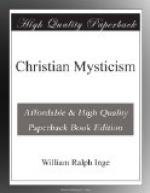(b) Salvation was regarded, as in the Oriental religions, as emancipation from the fetters of human existence. Doctrines of this kind were taught especially in the Orphic Mysteries, where it was a secret doctrine ([Greek: aporretos logos], Plat. Phaedr. 62) that “we men are here in a kind of prison,” or in a tomb ([Greek: sema tines to soma einai tes psyches, os tethammenes en to paronti], Plat. Crat. 400). They also believed in transmigration of souls, and in a [Greek: kuklos tes geneseos] (rota fati et generationis). The “Orphic life,” or rules of conduct enjoined upon these mystics, comprised asceticism, and, in particular, abstinence from flesh; and laid great stress on “following of God” [Greek: epesthai] or [Greek: akolouthein to theo] as the goal of moral endeavour. This cult, however, was tinged with Thracian barbarism; its heaven was a kind of Valhalla ([Greek: methe aionios], Plat. Rep. ii. 363). Very similar was the rule of life prescribed by the Pythagorean brotherhood, who were also vegetarians, and advocates of virginity. Their system of purgation, followed by initiation, liberated men “from the grievous woeful circle” ([Greek: kyklou d’exeptan Barypentheos argaleoio] on a tombstone), and entitled them “to a happy life with the gods.” (For the conception of salvation as deification, see Appendix C.) Whether these sects taught that our separate individuality must be merged is uncertain; but among the Gnostics, who had much in common with the Orphic mystae, the formula, “I am thou, and thou art I,” was common (Pistis Sophia; formulae of the Marcosians; also in an invocation of Hermes: [Greek: to son onoma emon kai to emon son. ego gar eimi to eidolon son]. Rohde, Psyche, vol. ii. p. 61). A foretaste of this deliverance was given by initiation, which conducts the mystic to ecstasy, an [Greek: oligochronios mania] (Galen), in which “animus ita solutus est et vacuus ut ei plane nihil sit cum corpore” (Cic. De Divin. i. I. 113); which was otherwise conceived as [Greek: enthousiasmos] ([Greek: enthousioses kai ouketi ouses en eaute dianoias], Philo).
(c) The imperishable Divine nature is infused by mechanical means. Sacraments and the like have a magical or miraculous potency. The Homeric hymn to Demeter insists only on ritual purity as the condition of salvation, and we hear that people trusted to the mystic baptism to wash out all their previous sins. Similarly the baptism of blood, the taurobolium, was supposed to secure eternal happiness, at any rate if death occurred within twenty years after the ceremony; when that interval had elapsed, it was common to renew the rite. (We find on inscriptions such phrases as “arcanis perfusionibus in aeternum renatus.”) So mechanical was the operation of the Mysteries supposed to be, that rites were performed for the dead (Plat. Rep. 364. St. Paul seems to refer to a similar custom in 1 Cor. xv. 29), and infants were appointed “priests,” and thoroughly initiated, that they might be clean from their “original sin.” Among the Gnostics, a favourite phrase was that initiation releases men “from the fetters of fate and necessity”; the gods of the intelligible world ([Greek: theoi noetoi]) with whom we hold communion in the Mysteries being above “fate.”




